Okay, let’s clear all of that medical mumbo-jumbo aside for one second. Benign Prostatic Hyperplasia- I know, so complicated. Let’s call it BPH. In reality, this is just a fancy way of saying that your prostate is going through a little anarchy as you age. It’s so common. In fact, if you are a 60 something man there is a greater than 50% chance your prostate is enlarging. By the time you are a man in your 70’s, nearly every man has this condition.
What Is BPH?
So what gives? Well, this is not a scary cancer diagnosis but it does come with some annoyances. It will create some disruption in your urination. For many men they may notice they are urinating much more often or feeling like they are standing in the bathroom forever waiting for a stream to start or feeling like their bladder is never really emptying. All of which are due to the enlargement of the prostate and it pressing against the urethra. So, this is not pleasant but there is some good news as there are several things we can do to treat the condition.
Common BPH Symptoms
Men with BPH typically experience frequent urination, especially at night, weak or interrupted urine stream, difficulty starting urination, and feeling like the bladder isn’t completely empty. These symptoms can significantly impact sleep quality, daily activities, and overall quality of life.
Medication-Based BPH Treatment
Here’s how BPH treatment typically plays out in clinical practice. Most physicians start with medication, so they can manage symptoms effectively while avoiding invasive procedures at the outset if a medical approach works to relieve symptoms. An alpha blocker such as tamsulosin is often the first-line therapy—alpha blockers works to relax the smooth muscle in the prostate so there is less difficulty urinating. These medications typically cause quite noticeable improvement in days to weeks–so there is relatively prompt relief.
The next class of medications is a 5-alpha reductase inhibitor, such as finasteride. This class works differently than the alpha blockers, and the name reflects that they work to gradually reduce the size of the prostate (rather than relaxing the smooth muscle). There is nothing immediate about the action of these medications, and it can take anywhere from three to six months to receive significant benefits, but they are very helpful in that the assumption is to provide long-term improvement in symptoms, and potential to eliminate the need for surgery in the future.
Some patients present with larger prostates or more significant symptoms, physicians may recommend a combination therapy, meaning an alpha blocker and a 5-AR inhibitor would be used. This can allow the physician to optimize relief of symptoms and occurs in cases where the symptoms are particularly complicated for the patient.
Minimally Invasive Procedures
If medications aren’t working for BPH, there are definitely less invasive options. Transurethral microwave therapy for instance, uses heat to destroy and remove excess prostate tissue. Or, there is prostatic urethral lift, were you insert small implants that hold the enlarged prostate tissue away from the urethra and thereby relieve the blockage.

Both typically can be performed under local anesthesia, and only require a patient go home the same day. Additional advantages include much less recovery time compared to traditional surgery. Most people can certainly appreciate that! Less recovery time is a critical factor for many people trying to juggle work and life!
Surgical Options
In more advanced circumstances, surgery may be required. TURP remains the gold standard; it is the procedure that removes extra prostate tissue through the urethra. However, new laser methods (e.g. GreenLight and HoLEP) are becoming more popular. While TURP is still the standard procedure, they may eventually produce comparable outcomes and potentially fewer complications. It is just a matter of providing each patient with the best fit.
Choosing the Right Treatment
The best bph treatment depends on symptom severity, prostate size, overall health, and personal preferences. Mild symptoms might only require lifestyle changes and monitoring, while severe symptoms typically need medical intervention.
Working with a urologist helps ensure you receive personalized treatment recommendations based on your specific situation. Regular follow-ups allow for treatment adjustments as needed, ensuring optimal symptom management and quality of life improvement.


